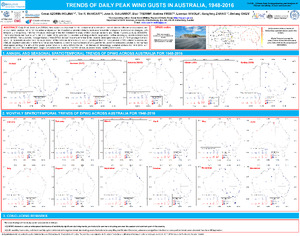Por favor, use este identificador para citar o enlazar este ítem:
http://hdl.handle.net/20.500.11765/11893
Trends of daily peak wind gusts in Australia, 1948-2016
Registro completo de metadatos
| Campo DC | Valor | Lengua/Idioma |
|---|---|---|
| dc.contributor.author | Azorín Molina, César | es_ES |
| dc.contributor.author | McVicar, Tim R. | es_ES |
| dc.contributor.author | Guijarro Pastor, José Antonio | es_ES |
| dc.contributor.author | Trewin, Blair C. | es_ES |
| dc.contributor.author | Frost, Andrew J. | es_ES |
| dc.contributor.author | Minola, Lorenzo | es_ES |
| dc.contributor.author | Zhang, Gangfeng | es_ES |
| dc.contributor.author | Chen, Deliang | es_ES |
| dc.date.accessioned | 2020-05-22T11:22:58Z | - |
| dc.date.available | 2020-05-22T11:22:58Z | - |
| dc.date.issued | 2019 | - |
| dc.identifier.citation | EGU General Assembly (2019) | es_ES |
| dc.identifier.uri | http://hdl.handle.net/20.500.11765/11893 | - |
| dc.description | Póster presentado en: EGU General Assembly 2019 celebrada del 7 al 12 de abril en Viena, Austria. | es_ES |
| dc.description.abstract | Daily Peak Wind Gust (DPWG) time series are important for the evaluation of wind-related hazard risks to different socioeconomic and environmental sectors. Yet wind time series analyses can be impacted by several artefacts, such as anemometer changes and site location changes, both temporally and spatially, that may introduce inhomogeneities that mislead the study of their decadal variability and trends. A previous study (EGU2018-14546 and Azorin-Molina et al. 2019. Int. J. Climatol. 39(4), 2260-2277) presented a strategy in the homogenization of this challenging climate extreme such as the DPWG. The automatic homogenization of this DPWG dataset was implemented in the recently developed version 3.1 of the R package Climatol which: (i) represents an advance in homogenization of this extreme climate record; and (ii) produced the first homogenized DPWG dataset to assess and attribute long-term variability of extreme winds across Australia. Given the inconsistencies of wind gust trends under the widespread decline in near-surface wind speed (stilling), the aim of this poster presentation is to show DPWG trends in 35 Bureau of Meteorology operated stations for 1948-2016, with particular focus on the spatiotemporal magnitude (wind speed maxima) of DPWG at annual, seasonal and monthly timescales. | es_ES |
| dc.description.sponsorship | This work has been supported by the project “Detection and attribution of changes in extreme wind gusts over land” (2017-03780) funded by the Swedish Research Council. | es_ES |
| dc.language.iso | eng | es_ES |
| dc.subject | Trends | es_ES |
| dc.subject | Daily Peak Wind Gust | es_ES |
| dc.title | Trends of daily peak wind gusts in Australia, 1948-2016 | es_ES |
| dc.type | info:eu-repo/semantics/conferenceObject | es_ES |
| dc.relation.publisherversion | https://dx.doi.org/10.13140/RG.2.2.29614.36168 | es_ES |
| dc.rights.accessRights | info:eu-repo/semantics/openAccess | es_ES |
| Colecciones: | EGU General Assembly | |
Ficheros en este ítem:
| Fichero | Descripción | Tamaño | Formato | ||
|---|---|---|---|---|---|
| Trends_Azorin.pdf | 3,31 MB | Adobe PDF |  Visualizar/Abrir |
Los ítems de Arcimis están protegidos por una Licencia Creative Commons, salvo que se indique lo contrario.





